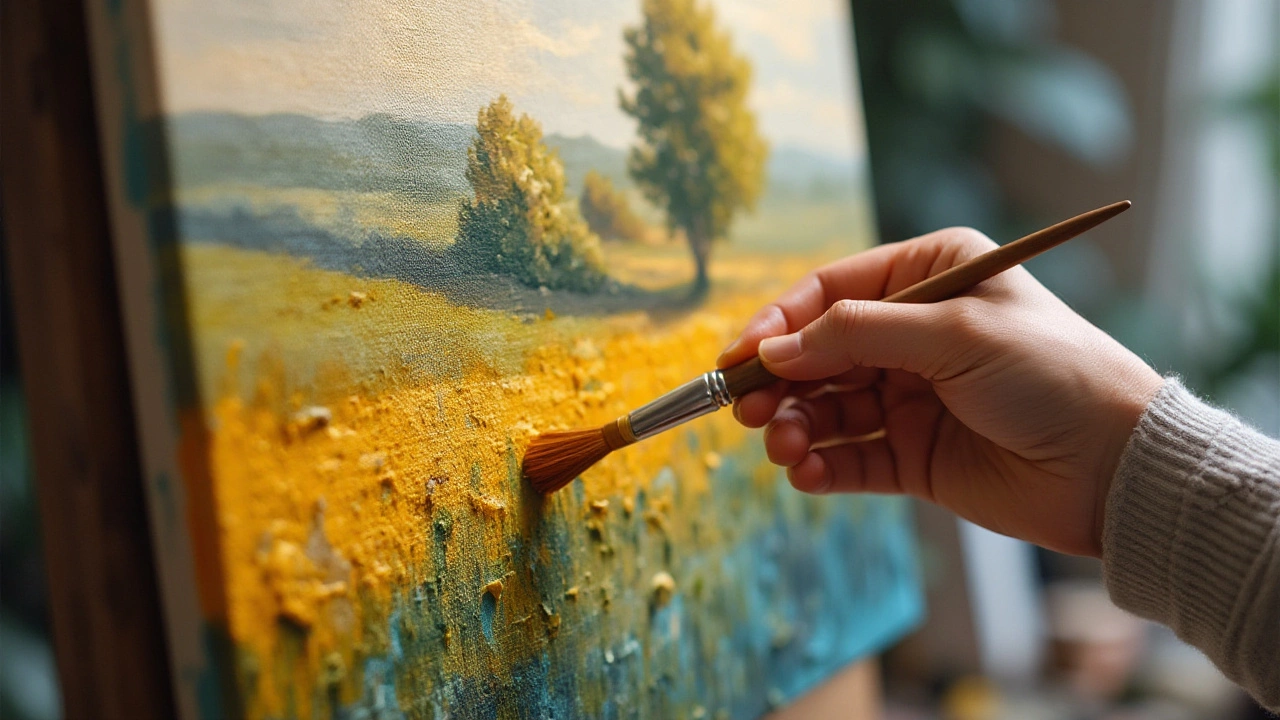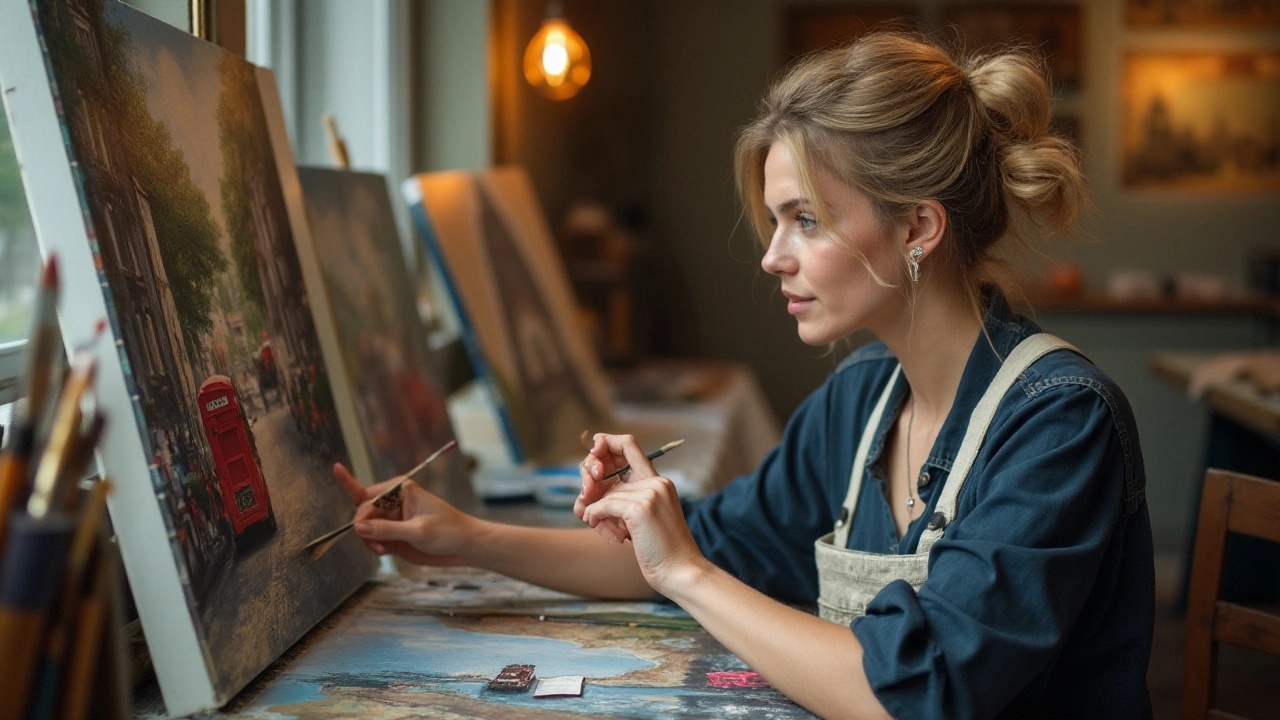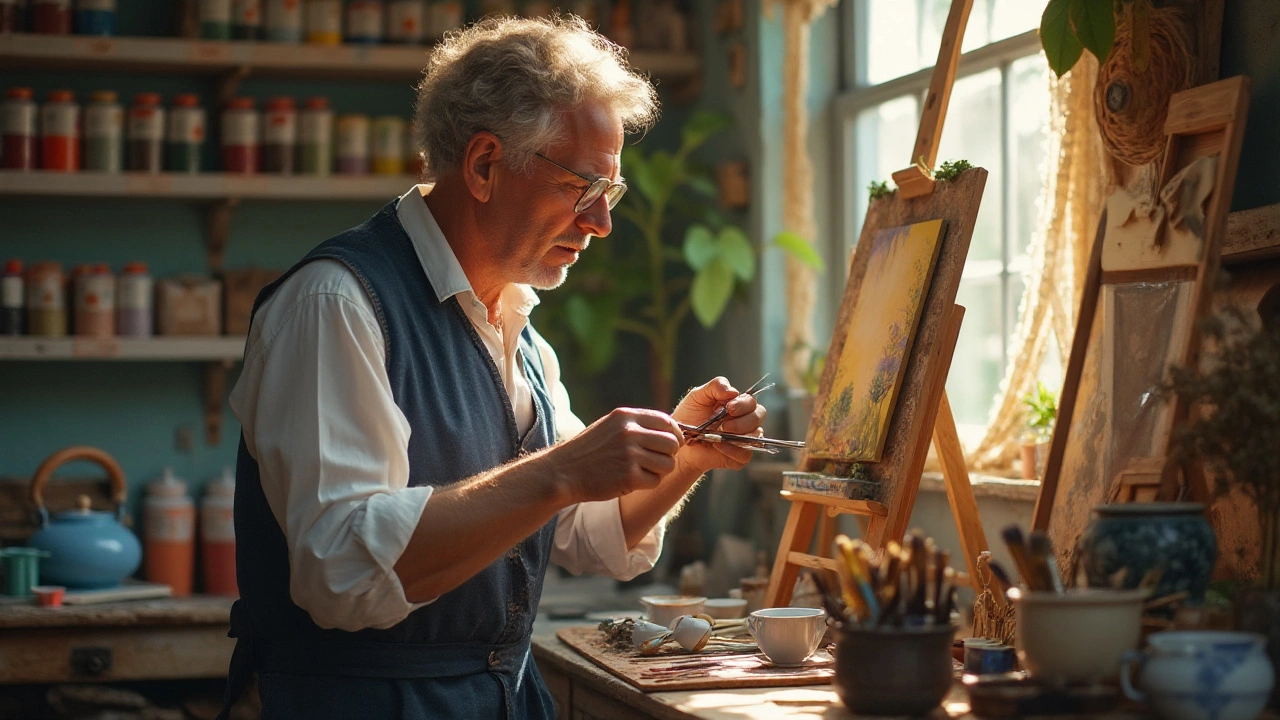Oil painting is a journey that invites both freedom and discipline, a delicate balance that hinges on the three pivotal elements known as the 3 P's—Preparation, Patience, and Precision. For artists eager to refine their craft, understanding and incorporating these aspects can profoundly influence the outcomes of their work and deepen their appreciation for the process.
Preparation might seem straightforward, but it sets the stage for creative exploration. This involves selecting the right canvas and materials, ensuring they are ready to support your artistic vision. Without a solid foundation, even the most brilliant ideas can falter.
Patience is the artist's greatest ally, especially when dealing with the slow-drying nature of oil paints. This characteristic demands that an artist strategize layers and colors with thoughtfulness, waiting for each layer to settle before advancing, thereby enhancing the richness and depth of their work.
Precision in technique—how an artist moves the brush across the canvas—can make all the difference. Mastery of brush techniques can bring about clarity and expression that animate a painting, offering the viewer an experience that conveys emotion and intent.
Embark on this exploration of the 3 P's, expanding your practice and pushing the boundaries of your creative process with confidence and flair.
- Preparation of Canvas and Materials
- Understanding the Medium
- The Role of Patience
- Achieving Precision with Brush Techniques
- Overcoming Common Challenges
- Incorporating Creativity with the 3 P's
Preparation of Canvas and Materials
The journey of creating a captivating oil painting begins long before the brush touches the canvas. It starts with a thoughtful preparation of both the canvas and the materials that will bring your vision to life. This foundational step might seem mundane, but it can significantly affect the outcome of your art. Choosing the right canvas is the first major decision. Artists often prefer either cotton or linen canvases, each with its own texture and absorbency. Linen is known for its durability and smooth texture, which is often favored for its archival quality. Cotton, on the other hand, is more affordable and readily available, making it an excellent choice for beginners.
Priming the canvas is a crucial step that cannot be overlooked. The canvas must be adequately primed to ensure it is ready to accept the oil paint and to protect it from the damaging effects of oil seeping through the fibers. Gessoing is a process that involves applying a primer, usually gesso, to the surface. This creates a slick but absorbent layer on the canvas, allowing for smoother brush strokes. Applying two or three coats of gesso, allowing each layer to dry completely, is often recommended for the best results. Some artists even lightly sand between coats to achieve an ultra-smooth finish.
Selecting the right materials goes beyond just the canvas. The quality of oil paints, brushes, and other tools can impact your painting's appearance and longevity. Oil paints vary widely in grade and pigment concentration. Professional-grade paints offer more vibrant colors and better consistency due to their higher pigment content. Brushes, on the other hand, come in various shapes and sizes, each lending itself to specific techniques and effects. Flat brushes are excellent for broad strokes, while filbert brushes offer versatility that suits both details and broader shapes.
"An artist is not paid for his labor but for his vision," said James Whistler, a reminder that while materials are important, they serve merely to convey the artist's creative insight.
Organizing your workspace is another vital part of the preparation process. An orderly area can facilitate a more enjoyable and productive painting session. Ensure that your easel is positioned to maximize natural light or set up with adequate artificial lighting. Palettes should be laid out strategically, with colors arranged to prevent unnecessary mixing and to allow easy access. This setup can help maintain the vibrancy of your pigments—a key factor in producing striking oil paintings.
To ensure your preparation is comprehensive, consider creating a checklist of materials and steps needed before beginning any project. This proactive approach will help you avoid last-minute scrambles and allow you to focus on unleashing your creativity. A well-prepared canvas, coupled with quality materials, provides the solid foundation upon which your masterpiece will flourish. Remember, the care and consideration you invest into this initial phase reflect not only in the ease with which you paint but also in the finished product's quality and endurance.
Understanding the Medium
Oil painting is much like a trusty companion—faithful, versatile, and complex. To truly embrace this traditional medium, it is essential to comprehend its attributes and intricacies. Oil paint is renowned for its rich, vivid colors that create a depth and luster unmatched by other mediums. It is made by suspending pigments in oil, commonly linseed oil, which grants artists flexibility with drying times. This allows for extended blending and reworking periods, offering more control over the creative process. Understanding the drying behavior, which can range from days to weeks depending on environmental factors, is crucial for planning the subsequent phases of your artwork.
One vital aspect of oil painting involves the fundamental practice of applying paint in layers, commonly known as the 'fat over lean' technique. This method ensures the stability and longevity of the painting by using thinner layers underneath and gradually increasing the oil content in upper layers. The principle behind this technique is to avoid cracking during the drying process, as oil paint continues to dry and harden over time. Artists often apply an underpainting to establish values and tones before adding color, which allows for a structured approach to the painting.
Cézanne once said, "Oil paint is a material that, through patience and care, reveals an artist's true vision and ambition."
Another fascinating characteristic of oil paints is their diversity in textures and finishes. Different additives can change the consistency of the paint, making it thick and buttery or smooth and fluid. Artists can experiment with various mediums such as dammar varnish or turpentine to alter the paint's transparency and sheen. By mixing these media, painters can achieve distinct effects, from light glazes to impasto, where paint is laid thickly with visible brushstrokes. This versatility allows artists to express almost limitless creativity through texture.
It's also worth noting the significant role of color mixing in oil painting. The full spectrum of hues achievable with a simple palette of primary colors demonstrates oil paint's adaptability. Mastering this involves a strong grasp of color theory and practical mixing techniques. Artists learn to manipulate complementary colors to tone down vibrancy or use analogous colors for harmonious blends. Testing color combinations on a separate palette before applying them to the canvas can prevent undoing hours of work from an unwanted hue.
The longevity and durability of oil paintings, when properly executed, enable them to withstand the test of time. Museums around the world take pride in preserving oil artworks that have survived centuries. The techniques and materials employed by the likes of Rembrandt and van Gogh continue to inspire today's artists. However, demanding regular maintenance, these masterpieces remind us of the delicate balance between permanence and fragility in fine art.

The Role of Patience
In the world of oil painting, patience is not just a virtue; it is an indispensable tool that shapes the very essence of the artwork itself. It's an art form renowned for its unique ability to preserve vibrant color and texture, largely due to its slow drying times. This characteristic asks the artist to cultivate an affinity for waiting, turning that period into productive time for reflection and adjustment. Those who are new to oil painting might find the drying time frustrating, as it can take days, or even weeks, for a layer to fully settle. However, seasoned painters understand this as a gift, providing them the opportunity to reconsider elements of their composition and make deliberate choices. This inherently slow pace becomes a meditative practice, allowing the artwork to evolve thoughtfully and intentionally over time.
The science behind oil paints further underscores the need for patience. These paints are made by suspending pigment in a binder composed of oils like linseed or poppy seed. The drying process involves the oxidation of these oils, which hardens the film over time. This chemical transformation is gradual, ensuring that the painting retains its luminosity and richness once it dries. Working with this natural pace instead of against it can transform the creative process. Thereby, artists have the liberty to build layers, adding depth and dimension, a characteristic that is hard to replicate with other mediums.
An interesting fact about the drying process is that the environment can influence it significantly. Factors such as humidity, temperature, and even light can change how quickly or slowly this happens. Artists often find themselves considering the climate of their studio and how it plays a role in their timeline. A dry room, for instance, might hasten the process, which could be useful in certain phases, whereas a more humid setting could extend the working time, allowing more flexibility in making adjustments.
Art history offers timeless examples of patience’s role in creating masterpieces. The famous Mona Lisa, painted by Leonardo da Vinci, is believed to have taken him about four years to complete. Such dedication underscores how patience allowed him to layer glazes methodically, which contributed to the painting’s ethereal quality and depth. Today's artists also recognize that patience fuels creativity, clearing the way for exploration and expression, free from the pressure of expedience.
As the celebrated painter Lucian Freud once said, "A moment of patience in a moment of anger saves you hundreds of moments of regret." This wisdom resonates deeply within the art community, reminding artists that rushing through their work can lead to mistakes that require correction, ultimately consuming more time in the long run. Embracing patience becomes a practice of letting the painting reveal itself at its own pace.
Practically speaking, nurturing patience means establishing a rhythm that accommodates the requirements of oil paints. Artists can use this time to work on multiple paintings simultaneously, allowing one to dry while beginning another. This not only makes efficient use of time but also invigorates creativity by letting ideas cross-pollinate between works. Moreover, patience allows us to appreciate the finer details that might otherwise go unnoticed, helping create a piece that resonates on a deeper level with the viewer.
Achieving Precision with Brush Techniques
When it comes to mastering oil painting techniques, the role of precision cannot be overstated. The dance of the brush across the canvas is no simple feat, as it requires both control and finesse. Artists seeking to enhance their precision must first familiarize themselves with the myriad types of brushes available, each with its unique capabilities and purposes. From the broad strokes of a flat brush to the delicate details of a fine liner, choosing the right tool is akin to a chef selecting the perfect knife.
The grip one holds on the brush can influence the outcome as much as the brush itself. Holding it too close might stifle gentle strokes, while too far down the handle can lead to a lack of control. Artists often find a balanced grip, somewhere near the center, allows them the flexibility to switch between bold and subtle marks seamlessly. It is this intricate dance of distance and contact that defines precision within the painter’s repertoire.
A lesser-discussed but equally vital technique is the palette knife's role in blending and precise application. Using it can unleash bold, textured strokes that are impossible to achieve with a brush alone. This can add depth and interest to the painting when applied carefully. The contrast between smooth brushwork and textured knife application can attract the viewer’s eye, guiding it across the canvas.
Understanding Brush Pressure
Brush pressure is critical to achieving varying effects with oil paints. Light pressure might imply transparency, allowing underlayers to peek through, while heavier pressure can create opacity and assertiveness. By consciously adjusting pressure, artists can impart their unique touch to the canvas, crafting works that express not just image but emotion. An interesting point to note is that the pressure applied at the beginning of a stroke can differ from the end, thereby giving life to dynamic and engaging contours in the painting.
For those looking to balance the myriad of these methods, a disciplined practice routine is essential. Many artists, both budding and established, dedicate time to sketching with paint in different forms and styles. This consistent practice can reveal personal nuances that might otherwise remain unexplored. As famed painter Leonardo da Vinci once suggested, "Simplicity is the ultimate sophistication." In the realm of oil painting, such simplicity comes with clarity and purpose, making each stroke count impeccibly.
Maintaining Steadiness
Achieving precision also necessitates the nurturing of steadiness—both of hand and mind. Simply put, painting requires that an artist remains conscious of their intentions, ensuring that the mind is as steady as their brush. Techniques like deep concentrated breathing and frequent, brief pauses can help maintain mental clarity during lengthy sessions. Confidence in one's choices can often mean the difference between a precise, confident line and a wavering one.
In an age dominated by speed and instant gratification, embracing patience and precision with these particular painting techniques can set apart an artist's work, attracting admiration for their skill. By thoughtfully selecting brushes, adjusting pressure with intention, and calmly progressing, the layered beauty of oil painting unfolds gracefully beneath the deft manipulation of an artist.

Overcoming Common Challenges
Venturing into the world of oil painting brings about its unique set of challenges that can, at times, feel daunting. However, these hurdles are often stepping stones that lead to growth in technique and creativity. One of the initial challenges every artist might face is mastering the drying time of oil paints. Unlike acrylics, which dry quickly, oil paints afford the artist more time to work and rework their ideas, yet this extended period can also lead to unexpected blending and smudging if the canvas remains wet for too long. To navigate this, artists can employ the use of linseed oil or other drying agents that can accelerate the process, allowing for more calculated layering of colors without unintended mixtures. The balance between creative spontaneity and technical control often defines the artist's journey in this medium.
Another common predicament is the issue of color consistency. Achieving the perfect hue may seem effortless in concept but can prove elusive without a clear understanding of color theory and mixing techniques. The key is practice and patience—allowing yourself the time to experiment with different combinations and ratios. Artists often create detailed color charts as a reference guide, a realistic yet invaluable tool to maintain consistency across their work. Imagine painting the same scene on different canvases but with slight variations in shade; these color inconsistencies can disrupt the harmony of a collection. To avoid this, maintaining a journal of mixtures and techniques can serve as a personal color library. This hands-on reference can mitigate frustration and save time.
Working Through Creative Block
Even the most seasoned artists face the notorious creative block, a challenge as much mental as technical. Breaking through it may require stepping back or diverting your focus to a different subject or form of art. Sometimes simply changing your environment or routine can reignite the spark."Inspiration exists, but it has to find you working," said Pablo Picasso, a sentiment that encapsulates the balance between effort and creativity. One effective strategy is setting small, manageable painting goals. Instead of thinking about completing a masterpiece, focus on refining one technique or capturing a singular theme. This approach not only reduces pressure but also promotes continuous learning and experimentation, fostering a positive and productive mindset.
The perennial question of how to effectively deal with mistakes is another challenge fraught with anxiety, yet the very nature of oil painting is forgiving. With layers, mistakes can be painted over, turned into new designs, or even embraced as part of the creative process. Accepting errors as opportunities for growth and adaptation can transform a perceived error into an innovative feature of the composition. Building confidence in this way allows artists not to be tethered by fear but emboldened by curiosity. This philosophy cements one's resilience and adaptability, crucial aspects not only in art but in life itself.
Incorporating Creativity with the 3 P's
When you weave creativity into your oil painting, the magic truly begins with embracing the essential 3 P's—Preparation, Patience, and Precision. Painting, much like any other form of art, is a playground where inspiration and technique come together to create something extraordinary. A fundamental aspect of this is learning to work within and beyond the boundaries of these principles, allowing for an interplay that elevates your work from mere strokes of paint to strokes of genius.
Consider Preparation, where the canvas is like the blank page to a writer. It offers infinite possibilities but needs the right tools and mindset to transform potential into reality. Your choice of brushes, colors, and even the design of your space can greatly impact the outcome. Imagine a vividly prepared palette waiting to be employed, like words eagerly strung together to form a narrative. Exploring diverse textures, experimenting with mediums, and daring to mix unconventional colors can lead to innovative ideas that break through traditional norms. As Pablo Picasso once said,
The purpose of art is washing the dust of daily life off our souls.It reminds us of how profound and transformative a creative process can be.
Now, let's talk about Patience. In the world of oil painting techniques, patience isn't just a virtue—it's a necessity. The oil medium, known for its leisurely drying time, is both a gift and a challenge. It allows artists to rework and refine their art, giving room for reflection and adjustment. But this grace period necessitates patience, inviting the artist to slow down and delve deeper into their work. Akin to slow-cooked meals that burst with flavor, artworks developed over time often exude richness and texture. When you give your painting the time it demands, layers develop intricately, colors meld beautifully, and the overall depiction becomes much more compelling.
Precision is the final call to action. It's about wielding your brush with intent, ensuring every stroke serves a purpose in telling your story. Mastery of brush techniques opens a dance between control and spontaneity, where certainty meets surprise. While it’s important for lines to be crisp and colors to maintain clarity, it's equally crucial to leave room for serendipity in your creation process. The unexpected outcomes can sometimes become the signature elements that define an artist's style. By introducing calculated risks, artists can develop a unique voice that speaks volumes through their paintings.
These 3 P's are not just a formula but a philosophy. When balanced, they act as guideposts for the artist, helping navigate the complexities of creative expression. By cultivating these aspects in your practice, you can unlock a world of potential, pushing the boundaries of what oil painting can offer. Embrace the journey—each step forward is a step towards your creative freedom.

